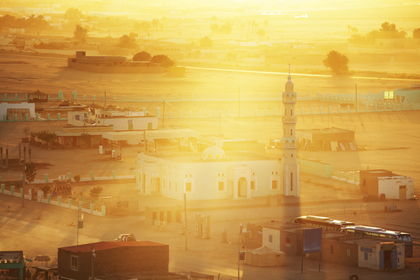SUDAN

Republic of the Sudan
Jumhuriyat as-Sudan
COUNTRY OVERVIEW
LOCATION AND SIZE.
Sudan is located in North Africa. Sudan borders the following countries: Central African Republic (1,165 kilometers, 724 miles), Chad (1,360 kilometers, 845 miles), Democratic Republic of the Congo (628 kilometers, 390 miles), Egypt (1,273 kilometers, 791 miles), Eritrea (650 kilometers, 404 miles), Ethiopia (1,606 kilometers, 998 miles), Kenya (232 kilometers, 144 miles), Libya (383 kilometers, 238 miles), and Uganda (435 kilometers, 270 miles). Sudan is the largest country on the African continent; its total area is 2,505,810 square kilometers (966,710 square miles), making the country slightly larger than one-quarter the size of the United States. The 853-kilometer (530-mile) long coastline borders the Red Sea and lies between Egypt and Eritrea. The Sudan's capital, Khartoum, is located in the central part of the country, on the Nile river.
POPULATION.
The population of Sudan was estimated at 35,079,814 in July 2000 and represents a net growth of 2.84 percent in comparison with 1999. Estimates increased to 36,080,373 by July 2001. The birth rate stood at 37.89 per 1,000 and the death rate at 10.04 death per 1,000 in 2001. In 1975, the total population was estimated at 16 million, in 1998 at 28.3 million, in 2001 at 36.1 million, and in 2015 it should reach 39.8 million.
The Sudanese population is highly diverse, consisting of about 19 different ethnic groups and almost 600 subgroups. Most of the inhabitants are of black African origin (52 percent), 39 percent are Arabs, 6 percent Beja, and 3 percent foreigners and other small national groups. Cultural conflicts between the black Africans, who live mostly in the south, and the Arabics, who live mainly in the north, have been the source of many internal struggles within the country. The official language is Arabic, which is spoken by about 60 percent of the population. An estimated 115 tribal languages are spoken as well, including Nubian, Ta Beawie, Nilotic, and Nilo-Hamitic. English and several Sudanic languages are also spoken.
The population is relatively young: while 45 percent are younger than 14 years old, only about 2 percent are older than 65. A majority of the population (69 percent) lives in the rural regions, while 31 percent live in the urban areas. The average population density is 9.8 per square kilometer (25.4 per square mile). The highest density is in the western and some southern provinces of the country, while the northern part of the country is rarely inhabited.
Population development and assessment is complicated by a continuing civil war and famine. Many people fall victim to the conflict or die as a result of the famine or diseases, and some of them escape to find asylum in Chad or Uganda. The average life expectancy is estimated at 55.85 years for men and 58.08 years for women. The literacy rate is 58 percent for men and 35 percent for women.
TOURISM.
Revenues from tourism could play a more important role in the future, but their contribution to the state budget is now very poor because of the low quality and standards. To increase revenues, the government, in coordination with the International Monetary Fund, has privatized many accommodations and tourist facilities. The government plans to enlarge usage of the Red Sea for special tourism activities, including wind surfing and diving possibilities. There are plans for the construction of new hotels, restaurants, and camps as well as tourist agencies. The Nile River could also be used for water sports.
The country has a total hotel capacity of 17,990 beds. The total number of hotels is 45, with another 48 in construction. There are 3 tourist resorts, 8 youth hostels, and 2 tourist camps. There are 3 five-star hotels in Khartoum (the Hilton, Grand Holiday Villa, and Palace), 1 four-star hotel (Meridien), and 5 three-star hotels. Khartoum and Port Sudan have the most accommodations.
Development of the tourism sector is complicated by the conflict in the south of the country and the unstable political situation. The government had difficulty attracting tourists and had difficulty getting Sudan added to the lists of world famous tourist places. Although the number of tourists is expected to grow in the future, Sudan could hardly attract as many tourists as neighboring Egypt at the end of 1990. Without a more stable political climate, Sudan will not be able to attract increasing numbers of tourists.
DEPENDENCIES
Sudan has no territories or colonies.
BIBLIOGRAPHY
Africa: South of the Sahara. European Publications Ltd., 1997.
Anderson, G. Norman. Sudan in Crisis: The Failure of Democracy. Gainesville, Florida: University Press of Florida, 1999.
Bank of Sudan. <http://bankofsudan.org> . Accessed October 2001.
Economist Intelligence Unit. Country Profile: Sudan 1999-2000. London: Economist Intelligence Unit, 2000.
International Historical Statistics: Africa, Asia and Oceania 1750-1993. Macmillan Reference Ltd., 1999.
International Monetary Fund. International Financial Statistics Yearbook 2000. London: International Monetary Fund, 2000.
Kok, Peter Nyot. Governance and Conflict in the Sudan 1985-1995: Analysis, Evaluation and Documentation. Berlin: Deutsches Orient Institut, 1996.
Sidahmed, Abdel Salam. Politics and Islam in Contemporary Sudan. London: St. Martin's Press, 1996.
"Sudan." WTC Corps. <http://www.wtc-corps.org/resources/sudan.htm> . Accessed October 2001.
U.S. Central Intelligence Agency. World Factbook 2001. <http://www.odci.gov/cia/publications/factbook/index.html> . Accessed September 2001.
World Bank. Human Development Report 2000. London: WorldBank, 2000.
World Bank. World Development Indicators 2000. London: World Bank, 2000
—Tomas Strnad
CAPITAL:
Khartoum.
MONETARY UNIT:
Sudanese dinar (SDD). One Sudanese dinar equals 100 piastres. There are bills of 10, 25, 50,100 and 1,000SDD.
CHIEF EXPORTS:
Cotton, sesame, livestock, groundnuts (peanuts), oil, gum arabic.
CHIEF IMPORTS:
Foodstuffs, petroleum products, manufactured goods, machinery and transport equipment, medicines and chemicals, textiles.
GROSS DOMESTIC PRODUCT:
US$35.7 billion (purchasing power parity, 2000 est.).
BALANCE OF TRADE:
Exports: US$1.7 billion (f.o.b., 2000 est.). Imports: US$1.2 billion (f.o.b., 2000 est.).
Comment about this article, ask questions, or add new information about this topic: